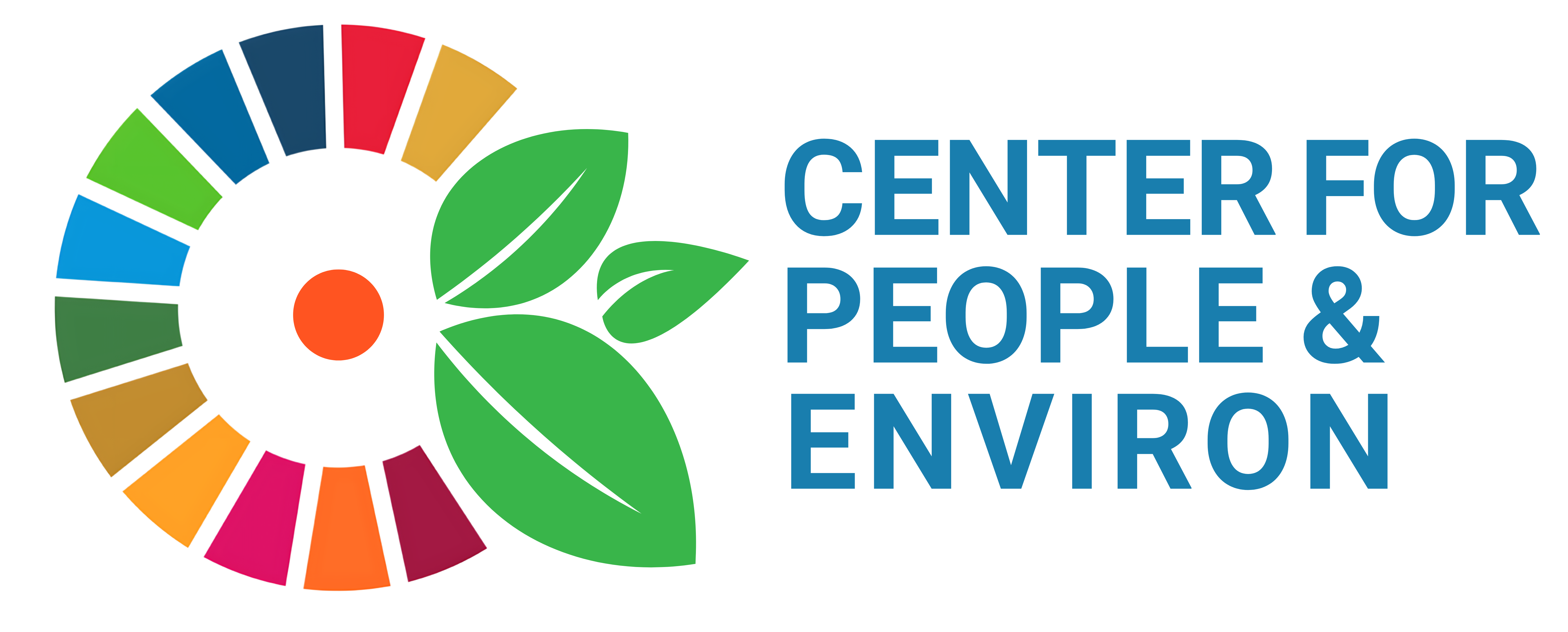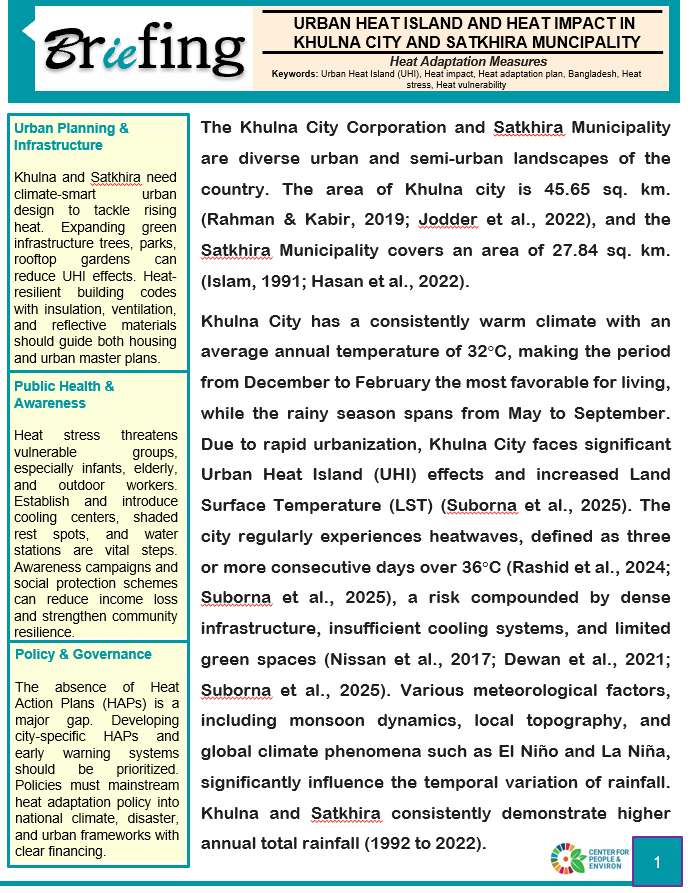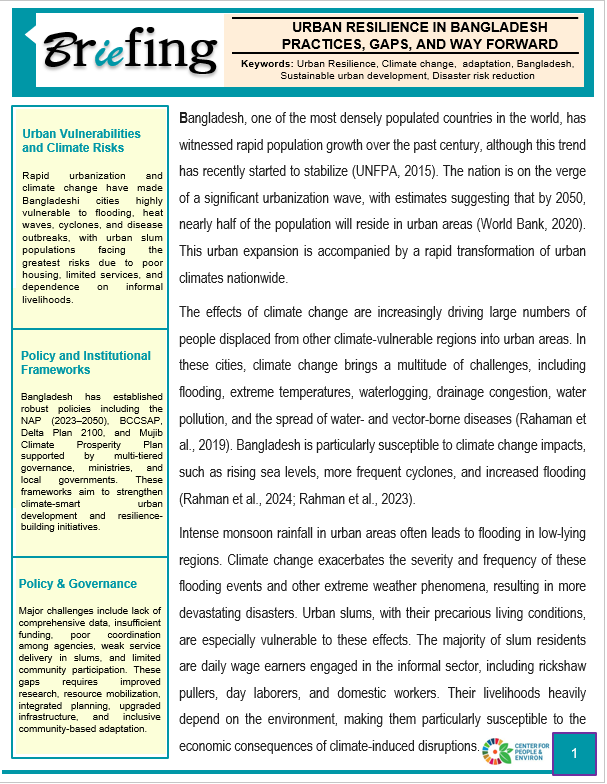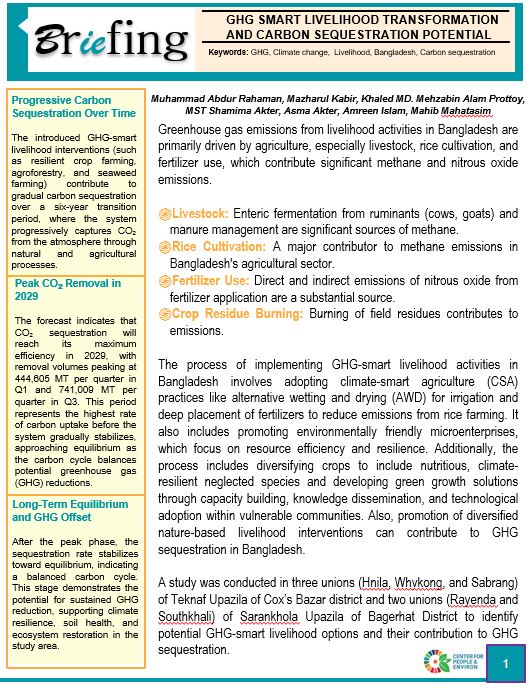Policy Brief Summary
Urban Heat in Khulna & Satkhira
Urban Heat Islands (UHI) in Khulna and Satkhira have sharply increased (1994–2024), driving higher land surface temperatures and frequent heatwaves. These cause severe health risks (heat stroke, dehydration, hypertension, dengue) and lost livelihoods, especially for vulnerable groups like infants, elderly, and informal workers.
Bangladesh has no heat adaptation plan. Urgent actions needed:
- Urban design: green spaces, NbS, climate-smart housing.
- Public health: cooling centers, stronger healthcare, social protection.
- Governance: city-specific Heat Action Plans and early warning systems.
Acknowledgment: Supported by American Red Cross & Climate Bridge Fund.
Policy Brief Summary
Urban Resilience in Bangladesh: PRACTICES, GAPS, AND WAY FORWARD
Bangladesh, one of the world’s most densely populated countries, is rapidly urbanizing, with nearly half its population projected to live in cities by 2050. This urban growth coincides with intensifying climate impacts, including flooding, heat stress, waterlogging, and disease outbreaks. Climate-induced displacement from rural regions is increasing population pressure in cities,
To address these challenges, Bangladesh has developed several key frameworks:
National Adaptation Plan (NAP) 2023–2050
Bangladesh Climate Change Strategy and Action Plan (BCCSAP, 2009),
Delta Plan 2100 and Mujib Climate Prosperity Plan (2020),
The Ministry of Environment, Forests and Climate Change (MoEFCC) leads coordination with other ministries and local governments. City corporations and municipalities are responsible for on-ground adaptation, though their limited resources constrain effectiveness. Community participation and civil society engagement are critical but often underutilized.
Initiatives such as the Urban Resilience Project (URP) and ICLEI’s Climate-Resilient City Action Plan (CRCAP) in Rajshahi exemplify efforts to improve disaster preparedness, promote green spaces, and integrate climate considerations into urban planning.
Despite progress, significant gaps remain, including insufficient data and funding, poor coordination, weak municipal capacity, inadequate services in urban slums, and limited community engagement. Strengthening data systems, financing, inter-agency coordination, and local participation is essential for building climate-resilient and inclusive cities in Bangladesh.
Acknowledgment: Supported by Climate Bridge Fund & BRAC
Policy Brief Summary
GHG SMART LIVELIHOOD TRANSFORMATION AND CARBON SEQUESTRATION POTENTIAL : Practices and Way Forward
Agriculture is the main source of greenhouse gas (GHG) emissions in Bangladesh, particularly from livestock, rice cultivation, and fertilizer use. These activities release large quantities of methane (CH₄) and nitrous oxide (N₂O), while crop residue burning adds further carbon emissions.
Key Emission Sources:
Livestock: Methane from enteric fermentation and manure.
Rice Cultivation: Continuous flooding generates methane.
Fertilizer Use: Nitrous oxide emissions from nitrogen-based fertilizers.
Residue Burning: Releases CO₂ and black carbon.
To reduce emissions, Bangladesh is promoting GHG-smart livelihood practices that enhance both emission reduction and carbon sequestration. These include climate-smart agriculture (CSA) techniques such as alternative wetting and drying (AWD) in rice fields, deep placement of fertilizers, agroforestry, and nature-based livelihood options.
A study conducted in Teknaf (Cox’s Bazar) and Sharankhola (Bagerhat) identified several promising interventions—resilient crop and homestead farming, podder farming, agroforestry, seaweed and seagrass cultivation, mangrove-based products, horticulture, and biofertilizer production. These practices improve soil health, water retention, and resilience while reducing agricultural GHG emissions.
Carbon Sequestration Forecast:
As shown in Figure 5.4, carbon sequestration is projected to peak in 2029, reaching 444,605 MT in Q1 and 741,009 MT in Q3, before gradually stabilizing as the carbon cycle balances GHG offsets.
Acknowledgment: Supported by the British Red Cross (BDRCS) and Center for Disability in Development (CDD).




